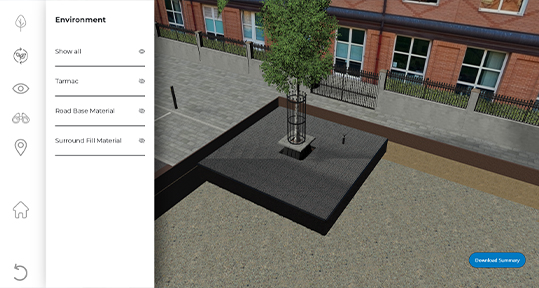Trees improve the livability of urban areas for many reasons. However for several years now, tree canopy in our cities and towns has been diminishing. Large mature trees which reach the end of their lives are frequently replaced with smaller species, or not at all. Then, replanted trees often struggle to establish and reach maturity due to the demands of engineered surfaces around them.
In this article, we outline nine of the main reasons why our cities need trees, and touch briefly on the systems available to specifiers and designers to help ensure new tree plantings have the chance to thrive. Landscape architects, urban planners, developers, and local authorities – listen up!
As time has gone on, more and more research has confirmed the value and benefits that mature urban trees offer our cities. Organizations such as ‘American Forests’ and ‘Trees Forever’ actively campaign in support of trees in urban areas. And the more mature the tree, the greater the benefits – so it’s critical that trees are planted with healthy growth and mature establishment in mind.
So let’s get down to business! Below are some of the principle benefits that trees bring to our cities:
Aesthetics
Few things can compare with the visual impact and seasonal interest that trees bring. They offer immense visual appeal to any area and will enhance the design of any streetscape.
Air Quality
For every 10% increase in urban tree canopy, ozone is reduced by between 3-7%.
Trees are proven to absorb carbon. After removing it from the air, it is stored as cellulose in their trunks, branches, and leaves (a process called sequestration). Planting trees remains one of the cheapest, most cost effective means of drawing excess carbon dioxide from the atmosphere (Tina Prow, “The Power of Trees”). A single mature tree can absorb carbon dioxide at a rate of 21.6 KG/year and release enough oxygen back into the atmosphere to support 2 human beings.
Research has also shown a 60% reduction in particulates from exhaust fumes in tree lined streets.
Health & Well-Being
Trees have a positive impact on the incidences of skin cancer, asthma, hypertension, and stress related illness by filtering out polluted air, reducing smog formation, providing shade from solar radiation, and giving an attractive, calming setting for recreation.
Pollutant Removal – sulphur dioxide, nitrogen oxides and particulates, carbon monoxide, cadmium, nickel, and lead are all substances that a tree works 24 hours a day, 7 days a week to remove and store.
Noise Reduction – trees form an effective sound absorbing barrier.
Biodiversity – the benefits of providing natural habitats for birds, squirrels, and other fauna are incalculable.
Cost Savings
According to the U.S. Forest Service, every $1 invested in trees brings a return of $2.70 in benefits. A similar study performed in the United Kingdom by ‘Natural England’ calculated that every £1 spent on tree planting would yield £7 savings, which if taken nationally would amount to potential annual savings of £2.1 billion.
Managing Stormwater
For every 5% of tree cover in a community, stormwater runoff is reduced by 2%. Trees prevent rainwater runoff from reaching water courses with the harmful chemicals it collects from urban roadways and sidewalks, while also reducing topsoil erosion.
Property Values
Trees can increase real estate values. Independent studies have shown a consistent 5-15% increase in property values on tree lined streets.
Community Improvement
Crime reduction – researchers have discovered reductions in both violent and petty crime, including domestic violence through the therapeutic, calming influence of mature tree planting.
Cooling Effects
Trees reduce temperatures by shade and transpiring water. This helps reduce air conditioning bills and energy use. One mature tree can produce the same cooling effect as 10 room-sized air conditioners. This becomes an effective tool in reducing urban heat islands and hot spots in cities.
Trees can also save up to 10% of local energy consumption through their moderation of local climate.
Wind Speed Reduction
Buildings increase wind speed as wind is forced to travel further around them. Trees significantly reduce wind speed up to a distance of 10 times their height.
Helping New Urban Trees Thrive
Trees in urban spaces face a difficult environment. Hard paved surrounds limit access to rainfall irrigation and the engineered requirements of hardscapes are the complete opposite of what the tree needs to grow into. GreenBlue systems help provide optimal conditions to give trees a chance to reach mature. Soil support cells allow for plenteous root growth while still providing the structural stability required for paved areas.
The ArborSystem brings together the key elements of successful tree pit design and simplifies the design and installation process for specifiers and contractors.
With all these benefits outlined, it’s important to understand that a large portion of urban trees that are planted do not reach maturity, therefore not providing the extent of the benefits that they could.





